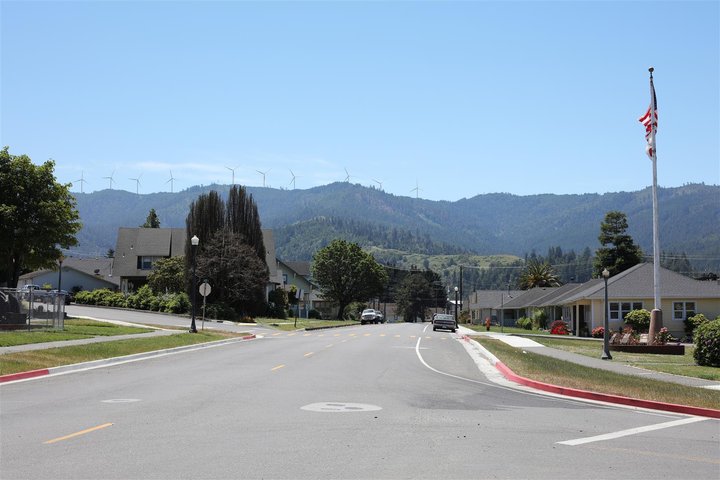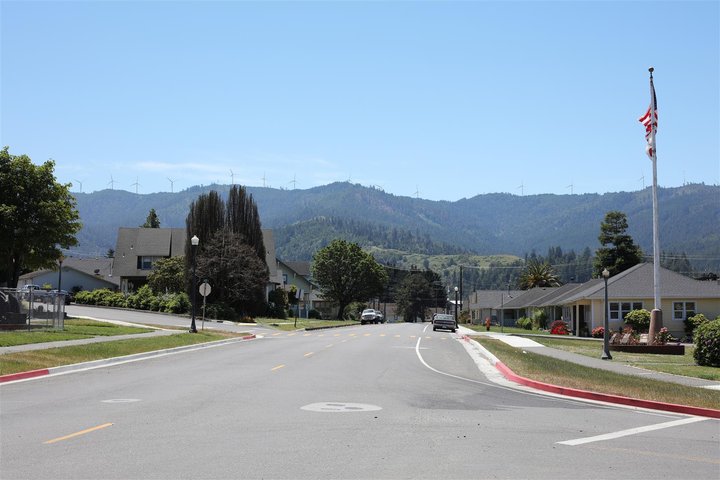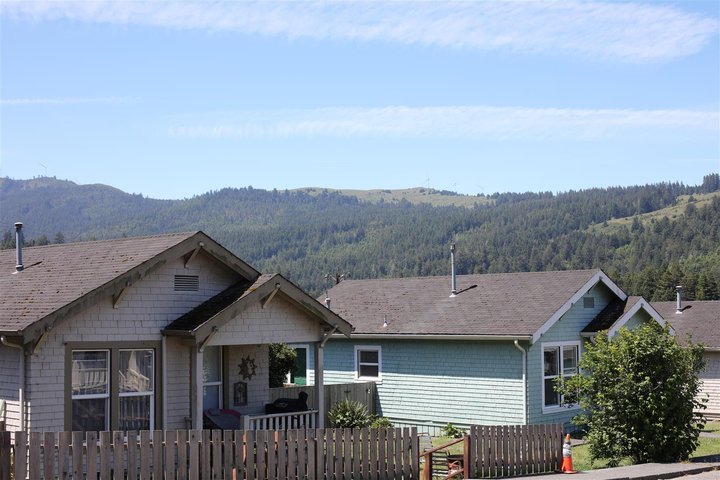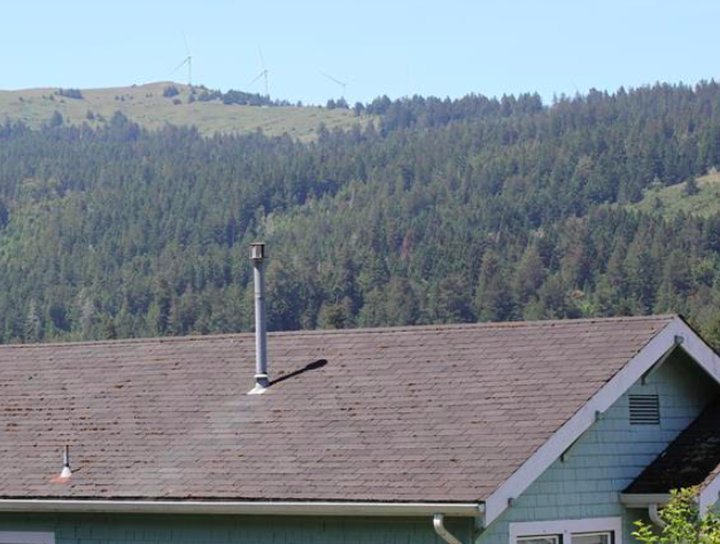
Simulation showing what it would look like from Scotia once large turbines are installed atop Monument Ridge. | Photos courtesy Terra-Gen.
Check out that photo above. Can you see the turbines on top of the ridge? According to Nathan Vajdos, senior director of wind development for San Diego-based renewable energy company Terra-Gen, that’s pretty much exactly how the real-life turbines will look to the naked eye once his company finishes installing as many as 65 of them atop Monument Ridge and Bear River Ridge, just south of the Eel River Valley.
On Tuesday morning Vajdos provided the Humboldt County Board of Supervisors an update on the major wind energy project currently in development for those ridges. The project, which could generate up to 155 megawatts of renewable energy, enough to power nearly 40,000 homes, is proceeding on an aggressive schedule. “We intend to be online by the end of 2020,” he told the board.
The project needs to move that quickly in order to work financially. “Terra-Gen is paying for the construction,” Vajdos said. “The only way we can get a return [on that investment] is by building [the wind farm].”
The plans are currently being reviewed under the California Environmental Quality Act, and an environmental impact report is expected to be ready for circulation sometime next year.
The proposed location for these massive windmills is more or less exactly near where Shell WindEnergy wanted to install a wind farm several years back, but the company met a lot of community resistance, with local residents complaining about the visual impacts, potential traffic during construction, and the potential hazard posed to local bird populations. Shell abandoned the project in 2012, citing transportation problems and unfavorable market conditions.
First District Supervisor Rex Bohn, who brought this latest project before the board in July, today credited Terra-Gen with handling the project better than Shell did theirs. Terra-Gen held public meetings ahead of time, in Eureka and Ferndale Fortuna, and they’ve enlisted the consulting firm Stantec to conduct “the most extensive bird study ever on the West Coast,” Bohn said.
Yasmine Akky, Stantec’s lead biologist on the project, was also in attendance at today’s meeting, and she said that while her company’s bird studies are similar to those conducted by Shell, they’re “orders of magnitude more robust,” accounting for all bird and bat species found in the region, with particular focus paid to the marbled murrelet.
Stantec has set up 15 survey points along the ridges where the turbine array would be installed, and biologists are collecting bird counts and other data, including avian flight paths, fall migration patterns, copulatory behavior and nesting surveys. The company is also using acoustic bat detectors. While Shell’s bird surveys lasted for roughly two months, Akky said, Stantec’s will extend from April to the following February for two years running. “They’re extremely robust,” she said.
There could be anywhere from 34 to 65 turbines installed on the ridgelines, depending on the size of the equipment the company ultimately uses. The number, size and configuration will be determined by environmental reviews. The largest of the potential turbines are roughly 600 feet tall with blades more than 240 feet long.
That photo at the top of this post was taken using expensive camera equipment (Bohn said the lens alone cost $47,000) designed to mimic human sight, according to Vajdos. It simulates the view if the larger turbines are used. Here’s what smaller ones would look like atop the ridge:

From a bit farther away, in downtown Rio Dell, they’d be barely visible, according to these simulations:

Don’t see ‘em? Here, we’ll zoom in:

The property atop these ridges is owned by the Humboldt Redwood Company and the local Russ family, which grazes cattle in the area. Both uses of the land could continue after installation, Vajdos said. Much of the massive equipment, including the enormous blades for the turbines, would be brought into Humboldt Bay by barge, with smaller materials coming over 299 via 18-wheelers. Once completed the energy generated by the turbines would be plugged into the grid at a PG&E-owned substation in Bridgeville.
Vajdos said Terra-Gen has been talking with the Redwood Coast Energy Authority and would love to provide some or even most of the project’s energy to that agency, which would likely result in lower bills for local consumers.
The project would provide up to 300 jobs during construction and 15 permanent jobs, according to Vajdos, and it stands to generate millions of dollars in tax revenue for the county, including $76 million in property taxes and nearly $8 million in sales taxes over the life of the project.
That would make Terra-Gen — or technically its local subsidiary, which is being called Humboldt Wind — the second largest taxpayer in the county, behind only PG&E.
Then there are the environmental benefits. Terra-Gen estimates that the project will prevent the emission of 372,000 metric tons of carbon dioxide, the equivalent of removing 80,000 cars from the road.
“Where I live in Texas not everybody believes in global warming,” Vajdos said. “I believe in global warming,” he added, and he said the residents of Humboldt County do too, by and large. “If citizens want to have a role in combating [climate change], you can do that by supporting this project. It’s a significant step.”
Fourth District Supervisor Virginia Bass said she took it as a good sign that none of the people who’ve expressed concerns about the project showed up to today’s meeting. She’d expected a full house and credited the company for addressing community concerns directly and proactively.
Third District Supervisor Mike Wilson said a project of this size has inevitable impacts, with visual and biological effects at the top of the list. But he compared those impacts to the prospect of an increase in global temperatures of two degrees Celsius, which scientists say will have catastrophic impacts to the planet’s ecosystems. (Popular Science stated it succinctly in the story linked above: “If the world gets warmer by two degrees Celsius, we’re screwed.”)
“I know this project isn’t the solution” to such a widespread problem, Wilson said, “but it will take all of us to adjust the way we view how we address these issues.”
As part of his presentation, Vajdos showed a segment of the YouTube video below. It’s from another company but provides a good sense of what it looks like to build such a project.
Terra-Gen plans to hold another community meeting on Nov. 13 at Scotia’s Winema Theater.
CLICK TO MANAGE